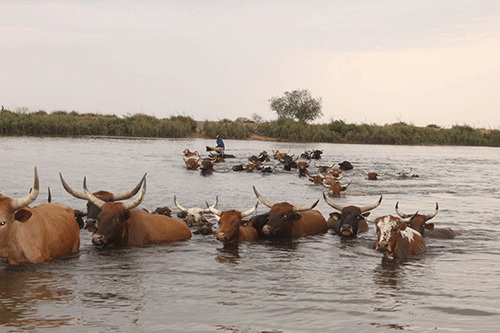The Ministry of Agriculture, Water and Land Reform on Friday announced the outbreak of Contagious Bovine Pleuropneumonia (CBPP), commonly known as Lungsickness, in the Kavango West region.
The disease was first detected in the Ncamagoro and Musese constituencies of the Kavango West Region on 28 February 2022.
“Farmers at Erago Crushpen in Ncamagoro Constituency, Sau and
Mayenzere Crushpens in Musese Constituency, notified veterinary officials in the region after observing some deaths and clinical signs in their cattle, mainly coughing.
The veterinary officials instituted immediate outbreak investigations and recorded 16deaths and clinical signs in over 20 cattle. Lungsickness was confirmed by the Windhoek Central Veterinary Laboratory from 10 March 2022. The source of infection is under investigation,” a statement by the ministry reads.
Lungsickness is mainly a disease of cattle and water buffalo caused by Mycoplasma mycoides sub-species mycoides SC, a type of bacteria that attacks the lungs of susceptible animals. In Africa, Lungsickness is known to cause greater losses of cattle than any other disease because it is highly contagious, and with a mortality rate of more than 50%.
Cattle deaths due to Lungsickness can be sudden. However, the disease often develops in a chronic form, resulting in subsequent cattle deaths over a period of time. Humans are not susceptible to Lungsickness, thus no public health risk.
Control measures
Lungsicknes is a State-controlled disease and in line with the Animal Health Act, 1 of 2011, the following control measures are put in place with immediate effect:
Based on the movement pattern of cattle around the infected areas, a complete movement ban of live cattle (except for direct slaughter) within, in and out of the Ncamagoro, Musese, Kapako and Mankumbi constituencies is imposed until further notice.
A number of roadblocks will be set up at strategic points, and members of the public are urged to fully cooperate with the veterinary and police officials.
Surveillance teams have been deployed in the region to establish the extent of the outbreak, and farmers are requested to cooperate and present their livestock for inspection.
The vaccination of all cattle in the region against Lungsickness will be conducted in the next few weeks, and all farmers are strongly urged to take their cattle for vaccination.
The following movements are allowed:
Movement of cattle for direct slaughter within the four constituencies.
Movement of raw (uncooked) beef and other products (with the exception of lungs), within the four constituencies and to other areas in the Northern Communal Areas must comply with existing veterinary protocols.
Movement of cattle for direct slaughter from the four constituencies to other areas in the Northern Communal Areas, provided they are slaughtered at abattoirs under official veterinary control.
Movement of live sheep, goats and other animals (except live cattle) and their products from the four constituencies to other areas in the Northern Communal Areas, provided they comply with existing veterinary protocols. Cattle for direct slaughter must also be moved under official movement permits, and get slaughtered within 72 hours of their arrival under veterinary supervision.
These cattle should not come in close contact with cattle not meant for slaughter at the place of destination.
Transmission and spread of Lungsickness:
Transmission of Lungsickness occurs through direct contact between infected and susceptible cattle through inhaling droplets through coughing. Chronically-infected cattle carry and spread the disease without showing signs of illness for longer periods of time.
Treatment of sick cattle with antibiotics is not recommended, as it may result in cattle that look clinically healthy but are still infected and able to spread the disease.
Clinical signs of Lungsickness
Coughing and nasal discharges, increased and difficult breathing, poor body condition (in chronically-infected cattle), infected cattle are often reluctant to move and graze poorly, sick cattle may become recumbent (lie down).
Post-mortem signs
Significant amounts of yellow fluids in the chest cavity, lungs adhering to the rib cage (lungs attaching to the ribs), on the cut surface of the lung, necrotic tissues (sequestra), accumulation of fluids are often seen.


